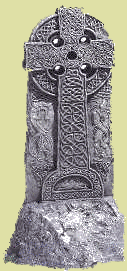
Celtic Christianity
 The Romans brought Christianity to the Celts in the last years of the Empire and was well established in Celtic Britain by the 4th century CE. After the conversion of the emperor Constantine, missionaries from the new Roman church set out to spread the Christian message to the barbarians of the north and west. In mainland Europe, where the original tribal culture had been largely replaced by Roman style civic organisation, the centralised Roman church was the natural successor to the old power-structures, and great centres of Christianity were established in cities such as Cologne, Trier, and Avignon. The church became a key part of governmental and civic activity, in what became known as the Holy Roman Empire. In the 5th century,however, the Saxons and other Germanic peoples invaded the country, driving most of the Celtic Christians into Wales and Cornwall.
The Romans brought Christianity to the Celts in the last years of the Empire and was well established in Celtic Britain by the 4th century CE. After the conversion of the emperor Constantine, missionaries from the new Roman church set out to spread the Christian message to the barbarians of the north and west. In mainland Europe, where the original tribal culture had been largely replaced by Roman style civic organisation, the centralised Roman church was the natural successor to the old power-structures, and great centres of Christianity were established in cities such as Cologne, Trier, and Avignon. The church became a key part of governmental and civic activity, in what became known as the Holy Roman Empire. In the 5th century,however, the Saxons and other Germanic peoples invaded the country, driving most of the Celtic Christians into Wales and Cornwall.
In the further reaches of the British Isles, where Celtic culture still held its own, and where the tribal chieftains were the major power-brokers, Christianity took on a different role. The message of Jesus' teaching was taken much more at face-value, as a set of values which was personal, and whose essence was humility. Rather than outposts of a Roman power structure, the first Christian missions founded by St. Ninian and St. Patrick worked in harmony with the values of the indigenous Celtic people (though it is questionable whether the founders themselves intended this). Rather than offering a centralised Roman religious authority, the early Celtic Church concentrated on more spiritual and social matters, and preached a culture of aesceticism, meditation and self-enlightenment, rather than the obedience and allegiance preferred by Rome.
 From this christian background it is that the second Golden Age of Celtic art emerges. Unlike in the earlier Pagan period, where weapons and jewellery are dominant, most of the great artefacts of the Christian period are associated with religious worship. Especially important are the manuscripts (mostly copies of the Christian gospels), stone crosses, plates and chalices used for the Holy Communion, and reliques which housed the remains of saints. But in common with pre-Christian Celtic art, the artists and scribes of this period made extensive use of knotwork decoration, zoomorph and spiral designs, and other techniques and styles of their Pagan past. From this christian background it is that the second Golden Age of Celtic art emerges. Unlike in the earlier Pagan period, where weapons and jewellery are dominant, most of the great artefacts of the Christian period are associated with religious worship. Especially important are the manuscripts (mostly copies of the Christian gospels), stone crosses, plates and chalices used for the Holy Communion, and reliques which housed the remains of saints. But in common with pre-Christian Celtic art, the artists and scribes of this period made extensive use of knotwork decoration, zoomorph and spiral designs, and other techniques and styles of their Pagan past.
At the same time, Saint Patrick and other British missionaries founded a new church in Ireland, which then became the center of Celtic Christianity. The Irish church developed a distinctive organization in which bishops were subordinate to the abbots of monasteries. The Irish monks, devoted to learning as well as religion, did much to preserve a knowledge of ancient Roman literature in early medieval Europe. Between the late 6th and the early 8th centuries, Irish missionaries were active in Christianizing the Germanic peoples that had conquered the Western Roman Empire, and they founded numerous monasteries in present-day France, Germany, Switzerland, and Italy. Celtic Christianity in Ireland was weakened by the Viking invasions of the 9th and 10th centuries, and by the 12th century its characteristic institutions, which were incompatible with those of the dominant Roman church, had largely disappeared from Europe.
Celtic Index
|







